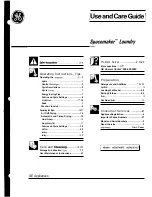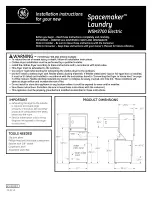
KCI 907.1E
13
Safety instructions
Connection and operation
■
Küppersbusch appliances are constructed in accordance with the relevant
safety regulations.
■
If the hob is operated with an oven installed underneath, this may only be
a Küppersbusch oven with fan cooling.
■
The appliances may only be connected to the mains, maintained and
repaired by a qualified electrician according to valid safety regulations. Work
carried out incorrectly places your safety at risk.
■
Persons with cardiac pacemakers or implanted insulin pumps must make
sure that their implants are not affected by the induction field (the frequency
range of the induction field is 25-50 kHz).
For the hob
■
Owing to the very fast reaction at the high power setting (power
level), do not use the induction hob without supervision!
■
When cooking, pay attention to the heat-up speed of the cooking zones.
Avoiding boiling the pots dry as there is a risk of the pots overheating!
■
Do not place empty pots and pans on cooking zones which have been
switched on.
■
Immediately switch off the cooking zone after using with the respective
minus key and not just by pot recognition.
■
Overheated fats and oils may spontaneously ignite. Food involving the use
of fats and oils, e.g. chips, may only be cooked under supervision. Never
extinguish ignited fats and oils with water! Put the lid on the pan and switch
off the cooking zone.
■
The glass ceramic hob is extremely robust. Avoid dropping hard objects onto
the the glass ceramic hob. Pointed objects falling onto your hob might break
it.
■
If cracks, fractures or any other defects appear in your glass ceramic hob,
immediately switch off the appliance. Disconnect fuse immediately and call
the Customer service.
■
If the hob cannot be switched off due to a defect in the sensor control
immediately disconnect your appliance and call the Customer service.
■
The glass ceramic hob should not be used as a storage area.
■
Do not put kitchen foil or plastic onto the cooking zone.
■
Metal objects, e.g. kitchen utensils, cutlery, must not be left on the surface
of the induction hob as they can become hot.
■
Take care with metal objects which are worn on the body if they come into
the direct vicinity of the induction hob as they can become hot. Non-
magnetisable objects (e.g. gold or silver rings) are not affected.
■
Do not heat any unopened food cans or laminated packing on the hob.
There is a risk of bursting!
■
Be especially careful to keep the sensor keys clean since soiling could be
mistaken for finger contact by the appliance. Never put anything (pans, tea
towels etc.) onto the sensor keys!
If food boils over onto the sensor keys, we advise you to activate the
emergency switch.
■
Hot pans should not cover the sensor keys, otherwise the appliance
switches itself off automatically. In this case the oven automatically shuts
off.
■
If there are any pets in the apartment which could come near the hob,
activate the child-proof lock.
Before using the appliance for
the first time
Remove foreign matter and packaging.
Before first use the hob should be cleaned with a damp cloth and a little
washing-up liquid.
The hob is resistant against thermal shocks (coldness and heat) and also very
robust.
Please observe the cleaning and servicing instructions.
The hob
The hob is provided with an induction cooking zone.
An induction coil underneath the glass ceramic hob generates an
electromagnetic alternating field which penetrates the glass ceramic and
induces the heat-generating current in the pot base.
With an induction cooking zone the heat is no longer transferred from a
heating element through the cooking pot into the food being cooked but the
necessary heat is generated directly in the container by means of induction
currents.
Advantages of the induction hob
– Energy-saving cooking through the direct transfer of energy to the pot
(suitable pots/pans made of magnetisable material are required).
– Increased safety as the energy is only transferred when a pot is placed on
the hob.
– Energy transfer between induction cooking zone and pot base with high
efficiency.
– High heat-up speed.
– The risk of burns is low as the cooking area is only heated through the pan
base, any food which boils over does not stick to the surface.
– Rapid, sensitive control of the energy supply.
Some instructions on cookware
The cookware used for the induction cooking zone must be made of metal,
have magnetic properties and a sufficient base area.
Only use pots with a
base suitable for induction.
This is how to establish the suitability of a pot:
Conduct the magnet test described below or make sure that the pot bears the
symbol for suitability for cooking with induction current.
Magnet test:
– Move the magnet towards the base of your cookware. If it is attracted, you
can use the cookware on the induction hob.
Note:
When using pots suitable for induction from some manufacturers, noises may
occur which are attributable to the design of these pots.
Suitable cookware
Unsuitable cookware
Enamelled steel pots with thick
base.
Pots made of copper, stainless
steel, aluminium, oven-proof glass,
wood, ceramic and terracotta
Cast iron pots with an enamelled
base.
Pots made of multi-layer stainless
steel, stainless ferrite steel and
aluminium with special base.



























